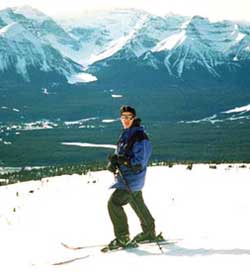Marcello Pavan
Marcello Pavan loves physics. He says that becoming a physicist is like joining the 'secular priesthood:' “some people get the calling and some people don't. I seem to have gotten the calling, and I don't know why.” The 'calling,' for Pavan, means a love for not only what he studies, but for the experience of working with other physicists. “There's no real sense that there's a hierarchy,” Pavan said. “Everybody seems to be at the same level. There's a camaraderie, sort of a shared purpose. If you need some help, you just go over and ask somebody. It's a great atmosphere to work in,” he said. “I love what I'm doing.”

Marcello Pavan
Pavan was born in Trail, British Columbia, a small, isolated town near the Canadian-U.S. border. “The closest big city was Spokane, Washington, 130 miles away,” he said. Pavan's father worked as a carpenter for a local smelter. Pavan went to college at the University of British Columbia, where he played goalkeeper for the university's soccer team, which won three Canadian championships.
When he came to UBC, he studied computer engineering, but later switched to Engineering/Physics. His senior thesis was to build a set of electrical amplifiers for the Tri-University Meson Facility (TRIUMF), a physics research lab at UBC. “I didn't know there was a nuclear and particle physics lab on campus,” he said. After working at TRIUMF, Pavan realized he was more interested in particle physics than in engineering. He stayed at TRIUMF for his Ph.D. After spending time studying in Trieste, Italy, and at MIT, Pavan returned to TRIUMF for a postdoctoral research position.
At TRIUMF, Pavan studies particles affected by the strong nuclear force, the strongest of nature's four fundamental forces, but one that appears only at distances of about one femtometer – 0.000000000001 millimeter, the size of the nucleus of an atom. Protons and neutrons are affected by the strong force, and so are more exotic particles such as pions. Pavan works on a research team that shoots a beam of pions at a target of protons, then analyzes what particles come out of the collision. His experiments can take years to plan. First, his team writes a proposal to use the machinery at TRIUMF. Then, they must build the particle detectors and electronics they will use to study the particles. In their current experiment, the team uses a sensitive magnetic detector twenty feet long and ten feet high. “That thing took years to build,” Pavan said. After the planning is complete, the team begins the actual experiments. They use magnets to steer the pions, which travel at speeds nearly 75% of the speed of light – fast enough to go from the earth to the moon in two seconds. While the experiments run, Pavan and his co-workers examine their tentative results, and constantly revise the experiments to make the results clearer. The experiments run 24 hours a day for several months.
After the experiments are complete, the team begins analyzing the data. The most difficult part of the analysis is figuring out what data come from meaningful pion-proton collisions and which come from other effects, such as pions striking the vessel that contains the experiment's protons. “Most of experimental physics, in fact, is separating the good stuff from the junk,” Pavan said. When all the analysis is complete, the team draws conclusions about the physics behind the collisions and publishes their results.
Pavan is still a postdoctoral researcher, or a short-term professional researcher, at TRIUMF, and he is looking for a full-time faculty job at another university. He spends a lot of time talking to the public about his research. “I love talking to youngsters about physics, and even to grownups,” he said. “What we do is so interesting, yet so misunderstood at times… and it's not so hard. After all, it's not rocket science.” He still plays soccer, but now in an amateur league with a group of friends. “I'm still playing all my old friends,” he said, “but I'm not as nimble as I used to be.” He also snow skis, camps, and mountain bikes. After spending four and a half years away, he is glad to be back in Vancouver. “Vancouver is still the best city I've come across,” he said. “It's the best part of the world.”
The only thing that could convince Pavan to leave Vancouver is finding a job as a physics professor at a university. “It's a terrific type of work to get into,” he said. “If you get the calling, just stick with it. The rewards are great.”











